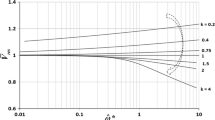This paper presents a summary and further development of the ideas proposed in the previous papers of the authors, which were dedicated to investigating the fiber scale effect (strength-length relation). In the first part of the paper, some theoretical aspects of the problem are considered; in the second one, an application to the processing of test datasets is discussed. As distinct from our previous publications, two types of defects (“technological,” i.e., existing before loading, and load-dependent) and two types of influence of the number of defects on the fiber strength are considered; the probability of absence of defects is also taken into account. We consider a specimen as a sequence of n elements of the same length. It is supposed that there are defects in K of them, 0 ≤ K ≤ n. Two cases are considered: K is a random variable or a random process K (t). In the second case, the increase in K and the failure of a specimen is described as a Markov chain whose matrix of transition probabilities depends on the current value of the loading process, described as some (increasing to infinity) sequence {x1, x2, …, xt,…}. Three versions of relationships between the specimen strength and the number of defective elements are considered for both the cases. Thus, six probability structures are introduced, and different versions of distribution functions and the corresponding models are considered. The methods for estimating the model parameters, the results obtained in processing glass, flax, carbon fiber, and carbon bundle datasets, as well as a comparison of different models, are presented in the second part of the paper.
Similar content being viewed by others
References
Yu. Paramonov and J. Andersons, “A family of weakest link models for fiber strength distribution,” Composites, Pt. A, 38, 1227–1233 (2007).
Yu. Paramonov and J. Andersons, “A new model family for the strength distribution of fibers in relation to their length,” Mech. Compos. Mater., 42, No. 2, 119–128 (2006).
Yu. Paramonov and J. Andersons, “Analysis of fiber strength dependence on length using an extended weakest link distribution family,” Comp. Model. New Technol., 11, No. 1, 8–20 (2007).
Yu. Paramonov and J. Andersons, “New weakest link distribution family,” in: Proc. Int. Conf. Statistical Methods for Biomechanical and Technical Systems, Limassol, Cyprus (2006), pp. 415–419.
Yu. Paramonov and J. Andersons, “New widened weakest link distribution family,” in: Proc. 12th Int. Conf. Appl. Stoch. Models Data Analysis (ASMDA-2007), May 29–June 1, Chania, Crete, Greece (2007).
Yu. Paramonov and J. Andersons, “Modified weakest link family for tensile strength distribution,” in: Proc. 5th Int. Conf. Mathem. Meth. Reliab. Methodol. Pract. (MMR 2007), July 1–4, Glasgow, UK (2007).
F. T. S. Pierce, J. Text. Inst., 17, p. 355 (1926).
W. Weibull, “A statistical theory of the strength of materials,” Proc. Roy. Swed. Inst. Eng. Res., 151 (1939).
H. E. Daniels, “The statistical theory of the strength of bundles of threads,” Proc. Roy. Soc. London, A183, 405–435 (1945).
C. Zweben, “Tensile failure of composites,” AIAA J., 12, 2325–2331 (1962).
C. Zweben and B. Rosen, “A statistical theory of material strength with application to composite materials,” J. Mech. Phys. Solids, 18, No. 3, 189–206 (1970).
W. F. Knoff, “Combined weakest link and random defect model for describing strength variability in fibres,” J. Mater. Sci., 28, 931–941 (1993).
Yu. Gutans and V. P. Tamuzh, “To the scale effect of Weibull distribution of the strength of fibers,” Mekh. Kompoz. Mater., No. 6, 1107–1109 (1984).
A. S. Watson and R. L. Smith, “An examination of statistical theories for fibrous materials in the light of experimental data,” J. Mater. Sci., 20, 3260–3270 (1985).
R. L. Smith, “Weibull regression models for reliability data,” Reliabil. Eng. Syst. Safety, 34, 55–77 (1991).
W. J. Padgett, S. D. Durham, and A. M. Mason, “Weibull analysis of the strength of carbon fibers using linear and power law models for the length effect,” J. Comp. Mater., 29, No. 14, 1873–1884 (1995).
W. A. Curtin, “Tensile strength of fiber-reinforced composites: III. Beyond the traditional Weibull model for fiber strengths,” J. Comp. Mater., 34, No. 15, 1301–1332 (2000).
J. Andersons, R. Joffe, M. Hojo, and S. Ochiai, “Glass fibre strength distribution determined by common experimental methods,” Comp. Sci. Technol., 62, 131–145 (2002).
J. Andersons, E. Spārniņš, R. Joffe, and L. Wallstrom, “Strength distribution of elementary flax fibers,” Comp. Sci. Technol., 65, 693–702 (2005).
Author information
Authors and Affiliations
Additional information
Translated from Mekhanika Kompozitnykh Materialov, Vol. 44, No. 5, pp. 685–696, September–October, 2008.
Rights and permissions
About this article
Cite this article
Paramonov, Y., Andersons, J. Analysis of the fiber length dependence of its strength by using the weakest-link approach 1. A family of weakest-link distribution functions. Mech Compos Mater 44, 479–486 (2008). https://doi.org/10.1007/s11029-008-9036-7
Received:
Published:
Issue Date:
DOI: https://doi.org/10.1007/s11029-008-9036-7




